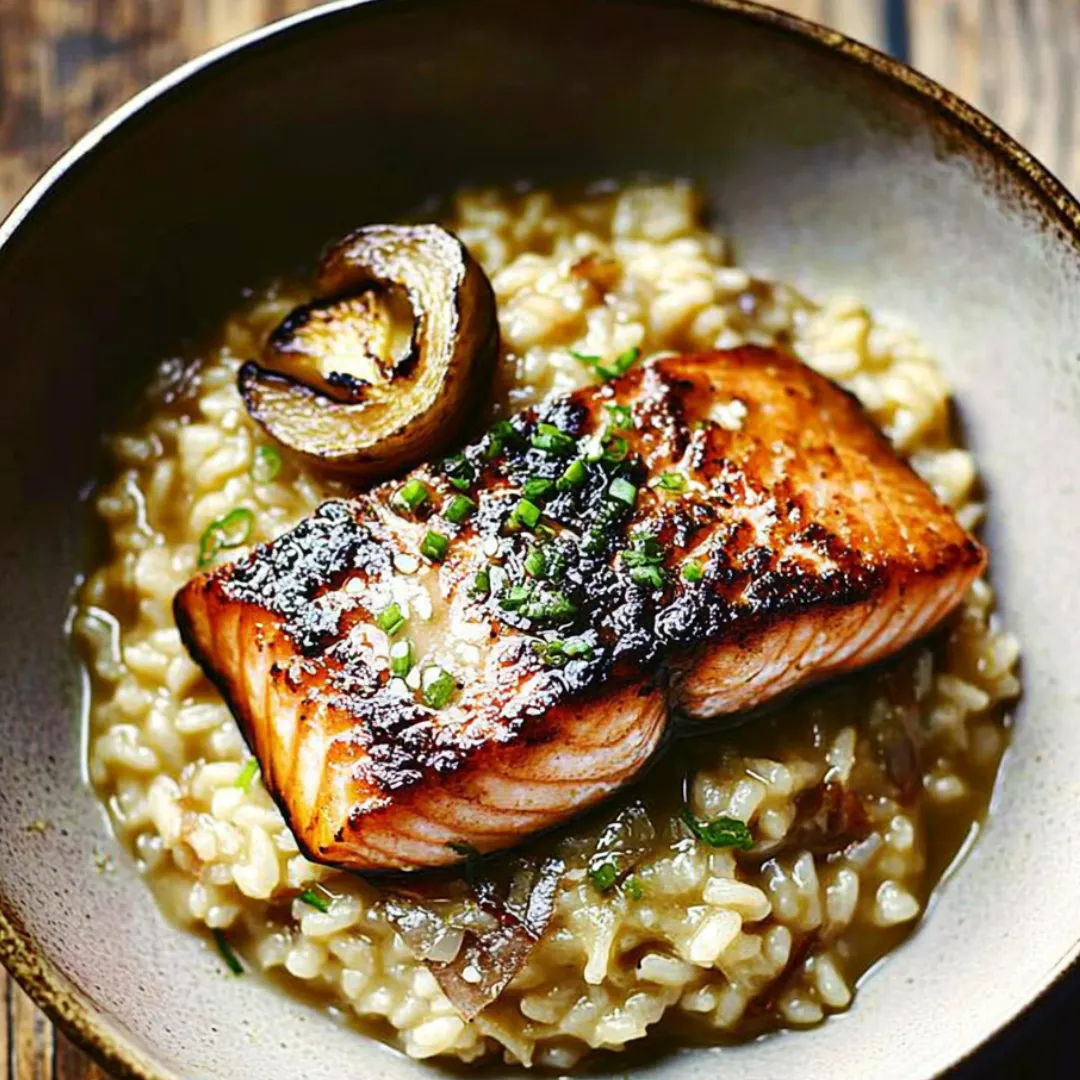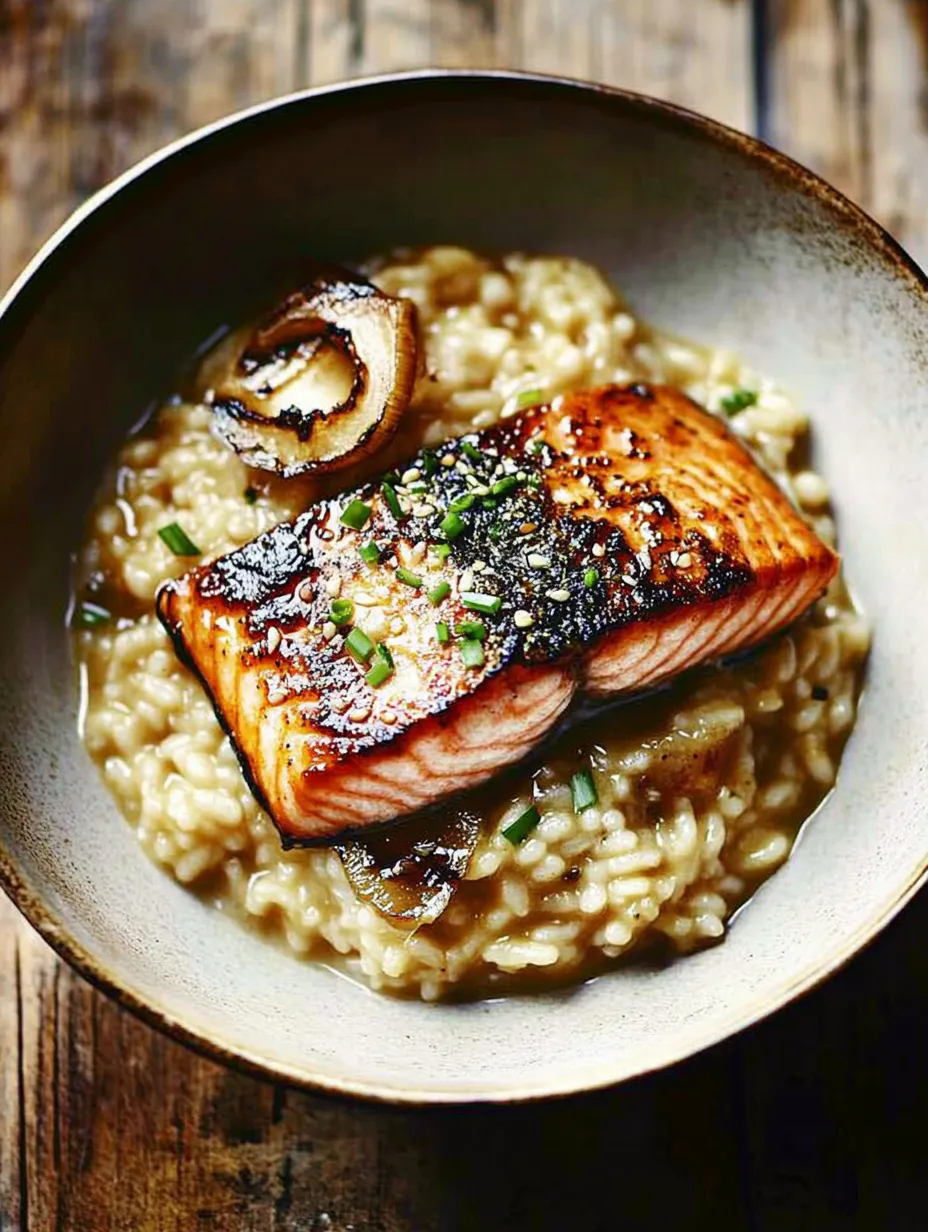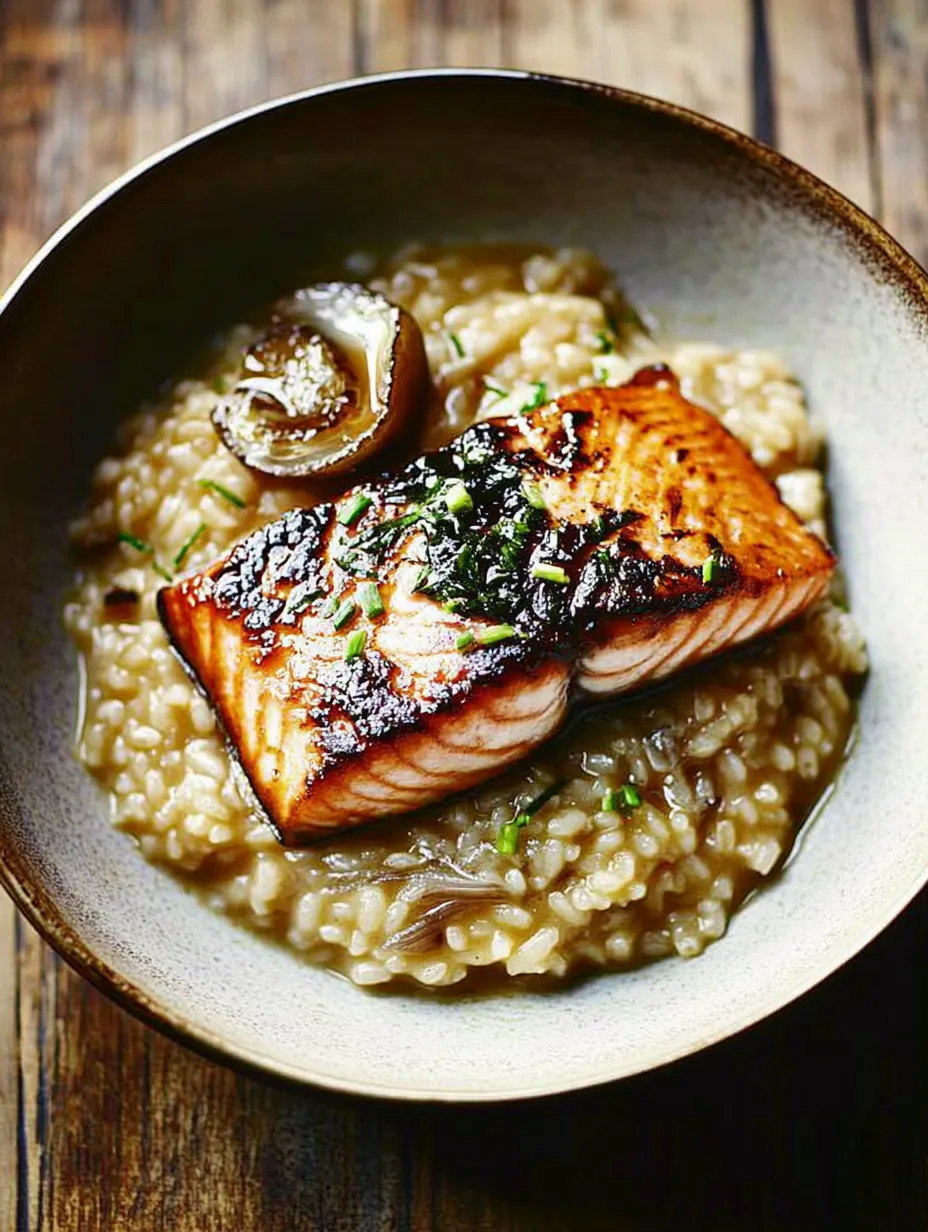 Pin it
Pin it
This Japanese-inspired risotto transforms traditional Italian technique with distinctly Asian flavors, creating something truly extraordinary. The magic happens when creamy, perfectly cooked rice infused with umami-rich miso meets soy-glazed salmon with its caramelized edges and tender, flaky interior. Each spoonful delivers waves of flavor – earthy shiitake mushrooms, savory miso, the subtle brininess of soy sauce, all rounded out with buttery salmon that melts in your mouth. Ready in about 40 minutes, this dish elevates everyday ingredients into something restaurant-worthy while remaining completely approachable for home cooks. It's the perfect balance of comfort and sophistication.
I discovered this fusion approach years ago when experiencing a creative slump with my usual dinner rotation. An impulse purchase of white miso paste led to experimentation, and this dish was born. The first time I served it to my husband, he went completely silent for several bites – always a good sign! He finally looked up and said, 'This might be the best thing you've ever cooked.' Now it's our go-to impressive yet comfortable meal for celebrations big and small. There's something magical about the way the salmon's glaze mingles with the creamy risotto that makes everyone at the table feel special.
Essential Ingredients
- 1 cup Sushi Rice: The foundation of our dish. Short-grain sushi rice creates the perfect texture – slightly sticky with distinct grains that still hold their shape. Its natural starchiness creates that signature creamy consistency without becoming mushy
- 8 ounces Shiitake Mushrooms: These bring intense umami and earthy depth. Look for firm caps with no sliminess. Remove the tough stems and slice the caps thinly for the best texture and faster cooking
- 2 tablespoons White Miso Paste: The flavor cornerstone of this fusion dish. White miso offers gentle sweetness and umami without overpowering. Always look for refrigerated miso in the produce section for the freshest flavor
- 4 Salmon Fillets (about 5-6 oz each): Choose center-cut portions of equal thickness for even cooking. Wild salmon offers superior flavor, but good-quality farmed salmon works beautifully too
- 3 tablespoons Low-Sodium Soy Sauce: Provides essential salinity and umami depth. Low-sodium allows better control over the final seasoning
- 3 cups Chicken Broth: The liquid that gradually transforms rice into risotto. Choose low-sodium broth so you can control the salt level
- ½ cup Dry White Wine: Adds brightness and acidity that balances the richness. A crisp Sauvignon Blanc works perfectly. You'll use some for the risotto and some for the salmon marinade
- 1 tablespoon Brown Sugar: Creates caramelization on the salmon and balances the soy sauce's saltiness. Light or dark brown both work well
- 1 medium Onion, finely diced: Forms the aromatic foundation of the risotto. Yellow or white onions work equally well
- 2 stalks Celery, finely diced: Adds subtle flavor and slight crunch. Make sure to dice it very finely so it cooks at the same rate as the onion
- 3 cloves Garlic, minced: Infuses the dish with essential aromatic notes. Fresh is non-negotiable here; pre-minced jarred garlic won't deliver the same punch
- Olive Oil and Butter: The combination provides ideal cooking fat – butter for flavor, oil for higher heat tolerance
 Pin it
Pin it
Step-by-Step Cooking Instructions
- Prepare the Salmon Marinade:
- In a shallow dish, whisk together 2 tablespoons of soy sauce, 2 tablespoons of white wine, and 1 tablespoon of brown sugar until the sugar fully dissolves. This quick marinade will create a gorgeous glaze that caramelizes beautifully during cooking. Place the salmon fillets in the marinade, turning to coat both sides. Let them sit at room temperature for 15-20 minutes while you begin the risotto. This brief marination time is sufficient to impart flavor without breaking down the delicate fish texture.
- Start the Mushroom Base:
- Heat a large, heavy-bottomed skillet or Dutch oven over medium-high heat. Add 1 tablespoon of olive oil, then add the sliced shiitake mushrooms in a single layer. The key here is not to overcrowd the pan – you want them to sear, not steam. Leave them undisturbed for 2-3 minutes until they begin to brown on one side, then stir and cook for another 2 minutes until golden and slightly crisp around the edges. Add a splash of soy sauce (about 1 teaspoon) to the mushrooms in the last 30 seconds of cooking, which will deglaze the pan and intensify their flavor. Transfer the mushrooms to a plate and set aside.
- Build the Risotto Foundation:
- In the same pan, reduce heat to medium and add another tablespoon of olive oil along with 1 tablespoon of butter. Add the finely diced onion and celery, cooking for 4-5 minutes until softened but not browned. Add the minced garlic and cook for another 30 seconds until fragrant. The aroma at this stage should be intoxicating – sweet from the onions with the distinctive punch of garlic.
- Toast the Rice:
- Add the cup of sushi rice to the pan, stirring constantly to coat each grain with the oil and butter. Continue stirring and cooking for 2-3 minutes until the edges of the rice grains become translucent while the centers remain white. This toasting step is crucial for developing flavor and ensuring the rice cooks evenly. The rice should make a gentle clicking sound against the pan and smell slightly nutty.
- Begin the Gradual Cooking Process:
- Pour in ¼ cup of white wine and stir constantly as the rice absorbs the liquid, which should take about 2 minutes. You'll notice the alcohol aroma dissipates as the wine reduces. Meanwhile, in a separate pot, warm your chicken broth and whisk in the white miso paste until completely dissolved. Keeping the broth warm ensures the risotto's temperature doesn't drop each time you add liquid, which would result in uneven cooking. Add the miso-infused broth one ladle at a time (about ½ cup), stirring frequently until each addition is nearly absorbed before adding the next. The stirring motion helps release the rice's starch, creating that signature creamy texture. This process should be gentle – a simmer, not a boil – and will take about 20-25 minutes total. The risotto should maintain a flowing consistency, neither soupy nor stiff. After about 15 minutes, start tasting the rice to check its progress – you're looking for al dente texture with a slight bite in the center.
- Sear the Salmon to Perfection:
- When the risotto is about 10 minutes from completion (after you've used about ¾ of the broth), prepare the salmon. Heat a separate non-stick skillet over medium-high heat. Add 1 tablespoon each of olive oil and butter. Once hot, remove the salmon from the marinade, letting excess drip off, and place flesh-side down in the pan. Cook for 3-4 minutes until a beautiful crust forms, then carefully flip and cook for another 2-3 minutes for medium doneness. The salmon should flake easily but still maintain a slightly translucent center for optimal juiciness.
- Complete the Risotto:
- When the rice reaches the perfect texture, fold in the reserved shiitake mushrooms and any accumulated juices. Add a final tablespoon of butter and stir gently until melted for extra creaminess. Taste and adjust seasoning with fresh black pepper and a touch more soy sauce if needed. The finished risotto should slowly flow when spooned onto a plate – what Italians call 'all'onda' or 'like a wave.'
- Plate with Purpose:
- Spoon the mushroom risotto onto warmed plates, creating a bed for the salmon. Place a glazed salmon fillet on top of each serving, then drizzle any remaining pan juices over the fish. The heat from the risotto will mingle with the salmon's caramelized exterior, creating an incredible flavor exchange. Garnish with thinly sliced scallions, a small sprinkle of toasted sesame seeds, or a few small shreds of nori for an extra touch of Japanese influence and visual appeal.
My Italian grandmother would probably roll her eyes at this fusion approach to risotto, but even she had to admit it was delicious when I finally convinced her to try it. She was particularly impressed with how the miso paste created that same depth that Parmesan brings to traditional risotto, calling it 'clever without being disrespectful.' Coming from her, this was the highest compliment possible! Now when she visits, she specifically requests my 'Japanese rice' as she calls it, and we enjoy it together while she shares stories of learning to make traditional risotto from her own mother back in Naples.
The Art of Perfect Salmon
Achieving restaurant-quality seared salmon at home comes down to a few simple but crucial techniques. First, always pat your salmon dry with paper towels before marinating – moisture is the enemy of a good sear. Second, resist the urge to move the salmon once it's in the hot pan; allowing it to develop a crust undisturbed is essential. The most common mistake home cooks make is overcooking salmon out of fear of undercooking. Remember that salmon continues cooking for a minute or two after removing from heat. For perfect doneness, look for the flesh to change from translucent to opaque about 75% of the way up the side of the fillet, then remove from heat – by the time it rests and is served, it will be perfectly cooked with a slightly translucent center that melts in your mouth.
Risotto: Meditation in Motion
Traditional risotto has a reputation for being labor-intensive, but I've come to view the process as a form of culinary meditation. There's something deeply satisfying about the rhythmic stirring, the gradual transformation of hard rice into creamy perfection, and the way the kitchen fills with layered aromas as each ingredient joins the pan. This Japanese-inspired version follows the same contemplative process. Rather than seeing the 25 minutes of active cooking as a chore, consider it an opportunity to be fully present with your food. The result is not just a better-tasting dish but a more satisfying cooking experience. Pour yourself a small glass of the same wine you're cooking with, put on some music, and embrace the process – your risotto will taste better for it.
Seasonal Adaptations
This versatile dish welcomes seasonal variations throughout the year. In spring, add tender asparagus tips or fresh peas in the final minutes of cooking. Summer calls for corn kernels or cherry tomatoes that burst with sweetness. Fall welcomes diced butternut squash (added earlier in the cooking process) or earthy mushroom varieties like chanterelles or oysters in place of shiitakes. Winter greens like spinach can be stirred in just before serving, wilting from the residual heat. The core flavors of miso and soy provide a consistent foundation that pairs beautifully with whatever is freshest at your market, making this a recipe you can return to throughout the changing seasons.
The Culture of Fusion Cooking
This Japanese-style risotto represents the beautiful evolution of modern cuisine, where traditional techniques from one culture meet ingredients from another. Japanese and Italian cuisines share a profound respect for simplicity, seasonality, and allowing ingredients to shine with minimal manipulation. Both traditions celebrate rice as a staple, though they approach it differently – Italian risotto emphasizes creaminess while Japanese rice cooking celebrates distinct grains. This dish honors both approaches, creating something new yet respectful of its influences. In our increasingly connected world, such fusion isn't just trendy but a natural evolution of cooking traditions that have always borrowed and adapted through cultural exchange.
 Pin it
Pin it
Make It a Complete Experience
To create a truly memorable meal around this dish, consider the entire dining experience. Serve this Japanese risotto with a simple starter of chilled cucumber salad dressed with rice vinegar, a touch of sugar, and sesame seeds. The cool crispness prepares the palate for the rich main course. For wine, a crisp Sauvignon Blanc or unoaked Chardonnay complements both the salmon and risotto beautifully. Alternatively, a cold premium sake makes a thematically appropriate and delicious pairing. Complete the meal with a light dessert that cleanses the palate – perhaps poached pears with a ginger syrup or yuzu sorbet. These thoughtful accompaniments elevate the entire dining experience without requiring extensive additional preparation.
After years of cooking both traditional Italian risotto and Japanese rice dishes, creating this fusion version has become one of my greatest culinary joys. There's something magical about watching someone take their first bite – the momentary surprise followed by that look of pure pleasure as the flavors unfold. What began as a simple experiment has become my signature dish, the one friends request when they visit and the meal I turn to when I want to show someone I care through food. The beauty of this dish lies not just in its complex flavors but in how accessible it is for home cooks. You don't need special equipment or obscure ingredients – just good technique and attention to detail. Every time I make it, I'm reminded that cooking is one of the most immediate ways we can bring joy to others, creating moments of connection around a table that far outlast the meal itself.
Frequently Asked Questions
- → Can I use brown rice instead of white rice?
- Yes, but brown rice takes significantly longer to cook (about 45-50 minutes) and requires more liquid. The texture will be chewier and less creamy than traditional risotto, but still delicious with these flavors.
- → What can I substitute for white miso paste?
- If you can't find white miso, you can use yellow miso (slightly stronger flavor) or red miso (more intense flavor, use less). In a pinch, substitute with 1 teaspoon fish sauce plus 1/2 teaspoon tahini or a tablespoon of soy sauce mixed with 1/2 teaspoon sugar.
- → Can I make this dish vegetarian?
- Yes, replace the salmon with tofu or portobello mushrooms (marinate and pan-sear them the same way), and use vegetable broth instead of chicken broth. The miso and shiitakes provide plenty of umami flavor.
- → What wine pairs well with this dish?
- A light to medium-bodied white wine with good acidity works best, such as a dry Riesling, unoaked Chardonnay, or Pinot Grigio. Sake is also an excellent choice to complement the Japanese flavors.
- → Can I prepare any components ahead of time?
- You can prepare the shiitake mushrooms a day ahead and refrigerate them. The salmon can be marinated for up to 2 hours in advance. However, the risotto is best made fresh, as it tends to thicken considerably when stored.
